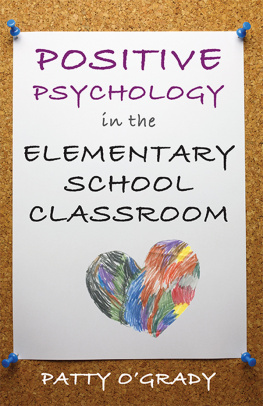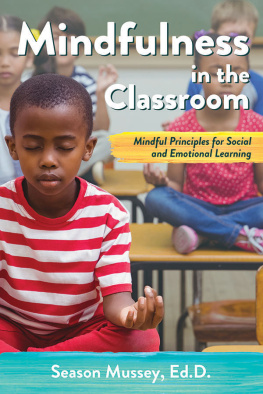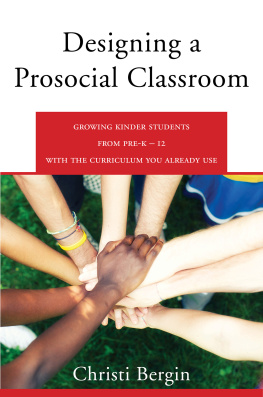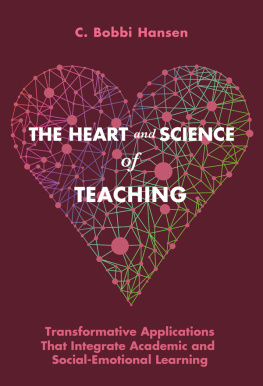
POSITIVE PSYCHOLOGY
in the
ELEMENTARY SCHOOL CLASSROOM
Patty OGrady, PhD

I dedicate this book to Amanda, who is my unofficial coauthor and who mastered the gift of positive psychology when she was 3 years old and gives it freely to everyone she meets.

C ONTENTS

Excellence is not a gift, but a skill that takes practice. We do not act rightly because we are excellent; in fact we achieve excellence by acting rightly.
Plato
As I write this book, I am sitting in a chair with my laptop looking out my window that overlooks the Seddon Channel in Tampa, Florida, where the dragon boats are assembling for the 2011 Tenth Annual International Dragon Boat Federation (IDBF) World Championship Dragon Boat Races. This is the highest level of competition in the sport of dragon boat racing and is hosted every two years in cities across the globe from Yue Yang, China (95), to Nottingham (99) to Shanghai (04). The competitors will race five different courses at 18 different competition levels.
While I write, dragon boat crews arrive from 27 different nations, from Australia and Brazil to India and Macau to Trinidad and Tobago. About 2,000 competitors paddle graceful boats that skim the water under my window. I am distracted, watching the boats and the crews. They revel in the pleasures of my pretty city. They cheer each other down the river, use their strong arms to move the boats effortlessly through the water, paddle together in perfect unison to the rhythm of the dragon boat drumbeat. They enjoy simply being a part of it all whether they win the race or not. Surely, this is the pleasant, good, connected, meaningful, and accomplished life floating on colorful display beneath my gaze.
There are 20 paddlers in each dragon boat, including a lead pair of paddlers who are called pacers or timers. All other paddlers synchronize their strokes with the pacer on the opposite side of the boat from where they sitnot with the pace paddler in front of thembecause the direction of the boat is propelled not by individual paddlers but by the crews sweep or momentum. The most important consideration in the cycle of the stroke is taking the paddle in and out of the water and keeping it straight up. A vertical orientation is the only way to maintain optimal paddle attitude. Properly executed, this upright move uses the gravitational weight of the paddler herself to generate an enormous impulse power that is not otherwise achievable. Upward and onward: similar to how aspects of positive psychology are related, the paddlers do not look ahead to compete but look to their partners to coordinate. They keep their paddles upright in the wind or in rough water to maintain optimal flow, and they work together to maintain forward momentum.
The paddlers also depend on the drummer, who sits at the front of the boat and calls the strokehe is the boats heartbeat. The paddler needs the drummers beat to work together rhythmically. The paddlers also need the sweep standing in the stern to call the directions and steer the boat down the center of the lane. In a positive psychology classroom, the children are the paddlers, the teacher is the sweep, and the lessons are the drum.
The spiritual and mystical history of the dragon boats lends itself to teaching the good life. Dragon boat makers construct a long boat, often of teak, decorated with a dragonhead at the front and a dragon tail at the back. The first boats date back 2,500 years when they raced on the Yangtze River in southern central China. Dragon boat racing is a happy part of the many Chinese water rituals and festivals that celebrate the venerable Asian water dragon. Annual dragon boat festivals are part of ancient ceremonial religious traditions that honor the mythical Asian dragon deities who, in Chinese culture, represent a spirit of strength and vitality. Dragons are regarded as wholesome and beneficent, and they are thus worthy of loyalty and celebration.
Among the dragon boat crews outside my window are teams of cancer survivors, inner-city children, and corporate executives. They are all friends, athletes, and competitors. They, and the families who applaud from the shoreline, are all happy and joyful, emanating a sense of physical and mental well-being. I am tempted to abandon my work and rush down to hand out well-being questionnaires in order to quantify what I observe.
Outside my window, the sun is shining brilliantly on the sparkling blue water and there is a flotilla of dragon boats in an array of strikingly different colors and patterns but all in the same shape. The teams are lively and spirited; they shout to each other, laugh, create a flow down the river, and enjoy the exhilarating emotions they feel, the signature strength they bring, the contribution they make to their team, the meaning of the festival, and the accomplishment of paddling as fast as they can down the course offering their personal bestwin or lose.
As the teacher in me watches from my window, I construct a positive psychology dragon boat curriculum in my head. From kindergarten to sixth grade, with just a little creative elbow grease, the dragon boats can easily teach children about history, art, music, philosophy, geography, mathematics, physics, biology, ecology, and more, with positive psychology at the core of it all. We can research the boats, write about them, build model replicas, measure them, decorate them, drum the rhythms, and learn the history of the countries that race them. The class will consider the positive emotion that paddlers must evoke to compete by appreciating the blue sky above and the calm sea below. The children can assess their signature strength by striving to become a lead paddler someday. They will understand how every paddler in the boat helps or hinders the race over the water and they know it matters to all the others how well each one performs in synchronicity. Lastly, the children will understand that the accomplishment is in crossing the finish line. Whether they win or lose, they figure out how to inspire the paddlers, drummer, and sweep to be excited to try again next year in some other wonderful part of the world as part of a festival that everyone enjoys. Surely, positive psychology is everywhere if we only know where to look for it and share it. This book intends to help teachers understand it, value it, and learn to use it with passion and proficiency. My ideas as to how to do it will end where yours begin: This book is meant to stimulate your ideas.
Building on childrens capacity to flourish in the classroom and throughout their lifetime must begin with a cohesive approach to teaching positive psychology. While the research and practice of social emotional learning begin the process, they bifurcate emotional learning and social skills rather than conceptualizing them across a continuum. To the extent that children develop neuroscientifically validated emotional strength, they are better equipped to apply these to the art of friendship and the pursuit of fulfillment in the quest for accomplishment. The focus of positive psychology is the cultivation of emotional strength. Those positive emotions and strengths can build relationships into true friendships and can imbue all learning activities with meaning.
My books starting point is Martin Seligmans positive psychology principles. I translate them into positive psychology practices for elementary school teachers. These practices are the tenets of Positive Emotion, Engagement through Strength, Relationships, Meaning, and Accomplishment. I begin with an overview of affective learning, including its philosophical and psychological roots, from finding the golden mean of emotional regulation to finding a childs potencies and golden self. The conversation then continues to connect the core concepts in educational neuroscience to the principles of positive psychology. Core concepts help to explain how feelings permeate the brain, affecting childrens thoughts and actions, how insular neurons make us feel empathy and help us learn by observation, and how the frontal cortex is the brains hall monitor. Neuroscience teaches us that there is no bad behavior, only poorly regulated emotions and underdeveloped strengths. This foundation shapes the positive psychology teaching taxonomy that identifies standards, indicators, methods, and techniques for veteran and novice teachers alike to use in the elementary school classroom. I hope that this book will validate some of the positive psychology methods and techniques that teachers may already use. For others, it may introduce a new approach to teaching the whole child.
Next page
















